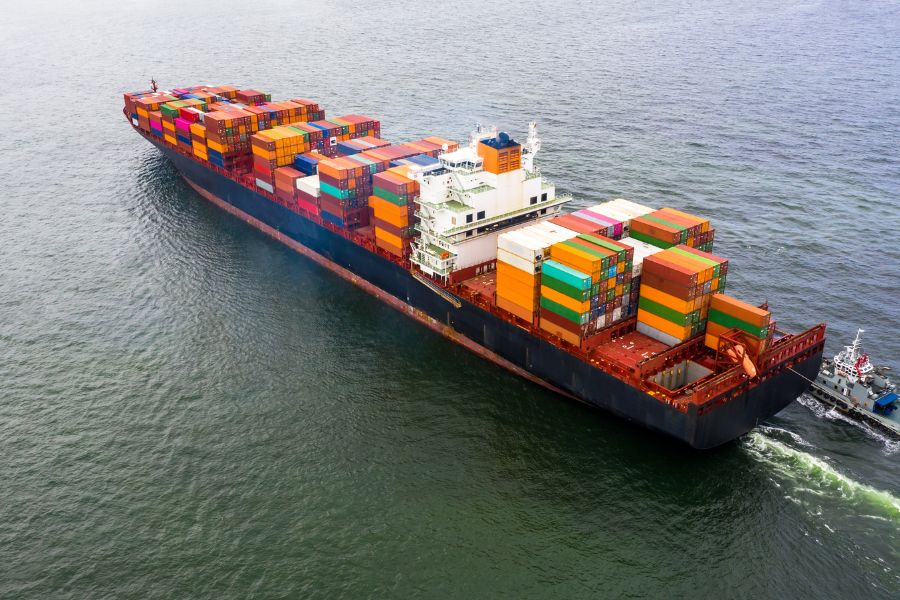Strategies for Maintaining Supply Chain Stability
Supply chain stability refers to a supply chain’s ability to operate smoothly, both during normal operations and when problems arise. When a supply chain is stable, companies can access the supplies they need to manufacture and ship their products, regardless of what is happening across the globe. Here, we’ll take a closer look at how companies can maintain stability within their supply chains.

Why Supply Chain Stability Matters
Getting a product from you to your customer depends on several factors. Not only do you need to design and create the product, but you also need to package and ship it to your customer. This entire process relies heavily on the supply chain.
A disruption can happen in any part of the supply chain, from raw material shortages to shipment delays due to weather. One disruption can create a ripple effect of delays in the rest of the supply chain, ultimately preventing product from reaching the end consumer.
Identifying Supply Chain Disruptions
Recent disruptions to the supply chain have come from various sources. Many started with the pandemic, and it has taken a number of years to return to pre-pandemic normality. Political instability has contributed to cross-border patrol closures and other supply chain challenges that have a global effect. Natural disasters, including hurricanes, earthquakes, and droughts, result in significant challenges and levels of stability within the global supply chain.
All of these concerns in recent years have shown the volatility of the supply chain. Using generative AI and machine learning, KPMG International Limited, in partnership with the Association for Supply Chain Management (ASCM), has crafted a metric to show the stability of the supply chain from year to year. The KPMG Supply Chain Stability Index measures 30 variables and performance indicators to see how the supply chain performs.
The index identified several key areas that led to the recent instability of the supply chain, including cyber attacks, disease, environmental, social, and corporate governance issues, in addition to geopolitical conflicts, such as ongoing wars. Here is a closer look at how some of these factors can impact the global supply chain.
Global Disruptions Impacting the Supply Chain
Maintaining a stable supply chain is challenging due to its global reach. Organizations depend on the global supply chain community to deliver products and supplies to where they need to go. However, global disruptions, such as changes in economies and governments, can disrupt this supply chain.
The global nature and complexities of modern supply chains imply that a business’s access to materials can be impacted by events occurring far away, such as changes in the geopolitical landscape, natural disasters, or major cybersecurity attacks. For instance, a war or trade embargo can create issues with global supply chains, while international pandemics, like COVID-19, can affect the availability of supplies.
Demand Fluctuations
Fluctuating demand can also create problems with the supply chain. Demand fluctuation makes it difficult to predict how much of a particular item to produce, and it can impact item pricing.
For example, if a market notices a reduction in demand for a particular packaging type, the supplier will make less of that type. Then, when there is a sudden increase in demand, it will be difficult to meet the demand quickly. This is just one example of how fluctuations in demand can hurt the supply chain. Demand volatility also increases the risks of:
- Stockouts
- Excess stocks
- Increased costs
- Delayed creation or shipping of products
Transportation and Logistics Issues
The supply chain is heavily dependent on the logistics sector. This is because products and supplies must be transported around the world to reach the necessary organizations in a timely manner. For example, if a company is waiting for a shipment of containers from a supplier before it can package and ship its own products, it has no choice but to wait for the shipment to arrive.
There are several factors that can disrupt the transportation industry, leading to delays or even complete shutdowns. One such factor is the digital technology that runs the shipping and trucking industries is vulnerable to attack. Geopolitical factors can lead to trade and shipping embargoes. Natural disasters and fuel shortages can impact a country’s ability to ship products and supplies. Even seemingly minor issues, such as traffic, can cause delays in transportation.
Supplier Reliability
Even when transportation and demand are not causing issues, companies still have to deal with suppliers that lack reliability. Companies should request historical data about the supply chain partners they choose to work with to protect their supply chain. Choosing suppliers with robust protocols and a long track record of success is essential.
Reliability is not always the supplier’s fault. For example, if a supplier is located in a war-torn region, they may not be able to ship their products due to their country’s political unrest, causing delays for the customers who rely on them that are outside their control.
Inventory Management
Inventory management strategies affect the entire supply chain. When a supplier experiences low inventory levels, and another supplier relies on that product to manufacture their own products, it creates a ripple effect that slows down the entire supply chain.
To mitigate the risk of supply chain disruptions, utilize proper inventory management practices, such as:
- maintaining optimal inventory levels
- implementing robust inventory tracking systems
- collaborating with suppliers who also demonstrate effective inventory management capabilities
By working together, companies can minimize the risk of inventory-related issues and ensure the smooth flow of goods throughout the supply chain.

Benefits of a Stable Supply Chain
A stable supply chain enhances business operations in a number of ways. Adoption of best practices for supply chain management brings several benefits, including:
- Ability to keep up with customer demand
- Optimization of shipping processes and costs
- Reduced overhead costs
- Real-time knowledge of where inventory is
- Faster responses to changes in demand or internal processes
Enhancing Your Supply Chain Stability
If your company is noticing problems with your supply chain, what can you do to increase stability? Here are some best practices to help ensure you have the items needed to deliver your products to your customers.
Diversify Suppliers
In supply chain risk management, diversification is crucial. When a company heavily relies on one or two suppliers and one of those suppliers encounters a crisis, the company’s ability to produce and deliver products may be compromised. To reduce this risk, having multiple suppliers acts as a fallback. In the event of delays or issues with one supplier, the company can seamlessly transition to another, ensuring that operations can continue as normal.
Implement Advanced Inventory Management
Incorporating technology into the supply chain has led to positive developments, such as advanced inventory management. However, it may be necessary for more organizations to adopt these advanced inventory management practices for the future success of supply chain management. Advanced inventory management leverages the latest data to track inventory levels and reduce the risks of stockouts and excess stock, ultimately enhancing the efficiency and effectiveness of the supply chain.
Optimize Logistics and Transportation
Data available through modern supply chain technology also provides actionable insights for the logistics and transportation sectors. Optimizing these will reduce the risks of supply chain concerns. Some strategies that can help include:
- Using technology to optimize routes to avoid shipping delays
- Improving warehouse operations to increase order fulfillment speed
- Implementing data to provide supply chain visibility so companies know the location and condition of products in transit
- Consolidating shipments to reduce the number of trucks, ships, and trips needed
- Reducing labor costs by implementing automation and robotics for loading and unloading shipments
Ensure Quality Control
Poor quality control can significantly impact the supply chain. Implementing quality control measures at various stages of the supply chain can limit the time and money lost due to poor-quality products and supplies. For quality control to be effective, it must be applied at every step of the supply chain.
Adopt Sustainability Practices
Sustainability in manufacturing encompasses more than just incorporating recyclable materials. It extends to environmental sustainability and ethical labor practices throughout the production processes. Supply chain sustainability is an integral part of a company’s branding but also impacts the stability of the supply chain itself. Over time, environmental damage resulting from excessive demands on the supply chain will negatively affect its stability by reducing the availability of products and supplies. Additionally, sustainability encompasses labor rules and regulations within the supply chain. Unsafe working conditions or unfair wages can lead to labor shortages, further jeopardizing the stability of the supply chain.

Maintaining Your Supply Chain Stability
In light of the global issues affecting markets and supply chains, individual companies should implement the following measures to ensure their personal supply chain remains stable:
- Implement real-time inventory management to maintain appropriate inventory levels.
- Make proactive changes to optimize inventory levels based on demand fluctuations and supply chain disruptions.
- Gather and utilize data to improve supply chain stability by identifying potential risks, optimizing routes, and enhancing supplier relationships.
- Leverage data to monitor supplier performance, assess their reliability, and identify areas for improvement or alternative sourcing options.
- Monitor and optimize cash flow by implementing efficient payment terms, managing inventory levels, and utilizing financial tools to mitigate risks.
- Consolidate shipments to lower costs, reduce transportation expenses, and improve efficiency by combining multiple orders into fewer shipments.
Leverage Technology
Advancements in technology have led to the development of inventory optimization and management technologies that offer real-time data on inventory levels. Thanks to technologies like the Internet of Things (IoT), more commonly called “smart” technologies, we can keep track of real-time data and inventory levels with the click of a button. This gives businesses valuable information to quickly make adjustments before facing stockouts of critical items and disruptions in operations.
Strengthen Supplier Relationships
Strong relationships with suppliers are a must. When your suppliers are in close contact with you, they can provide timely information about potential concerns, upcoming inventory issues, and even new products to better support you. In addition, suppliers often prioritize the partners they have strong relationships with, especially if inventory problems arise.
Implement Just-In-Time (JIT) Practices
Just-in-time inventory strategies limit the time, effort, and money you spend storing products and supplies. These strategies align your material supplier deliveries with the demand for your products so you are not storing supplies or products for a long time. Modern inventory management and forecasting technology make this strategy possible without risking your supply. The comeback of just-in-time inventory strategies helps companies maximize their supply chain and limit unnecessary risks.
Enhance Warehouse and Distribution Management
Optimizing warehouse and distribution center processes can significantly enhance supply chain efficiency. Implementing just-in-time practices, setting minimum order requirements, and automating warehouse operations are strategies that can help. By investing time in optimizing these aspects of the supply chain, companies can improve operational efficiency, reduce costs, and build a sustainable supply chain across their business.
Focus on Sustainability
Sustainability, both environmentally and with your talent pool, will support a stable supply chain. Disruptions in the labor force hurt your ability to deliver your products to your customers, so pay close attention and promote a healthy workplace culture that cultivates loyalty and longevity. At the same time, environmental sustainability ensures the long-term availability of the products and supplies needed for your company. As a bonus, sustainable supply chain practices allow you to reduce your carbon footprint and appeal to the goals of your customers and clients who want to work with eco-friendly companies.

Get the Support You Need to Stabilize Your Supply Chain
While today’s supply chain has seen tremendous improvement since the pandemic, there are still challenges to overcome and no guarantee that we will ever return to pre-pandemic normalcy. Working with a trusted partner to help manage the logistics of your business operations can help.
At Paramount Global, we have partnered with businesses like yours to provide complete packaging and supply chain solutions since 1976. Our inventory and supplier management services, combined with our international freight forwarding expertise, enhance the stability of your supply chain, contributing to your business’s success. Contact us today to learn how we can be a partner to you.
Hayley is a marketing professional and copywriter with a background in crafting content for a diverse range of industries. She has been writing about packaging and supply chain logistics for Paramount Global since 2022. She specializes in explaining complex topics in a clear and engaging way and is an advocate for sustainability in packaging and supply chain management.
Read More
For over forty years, Paramount has been delivering perfectly integrated packaging and supply chain solutions.
